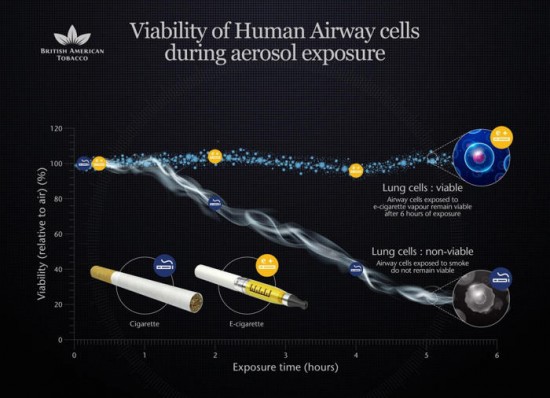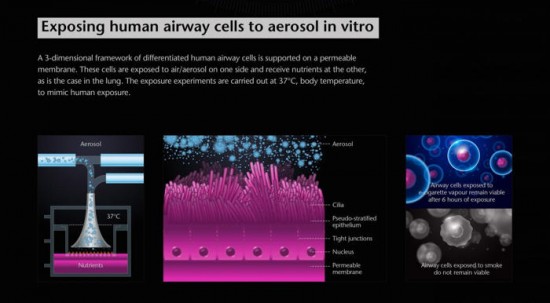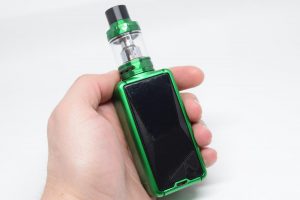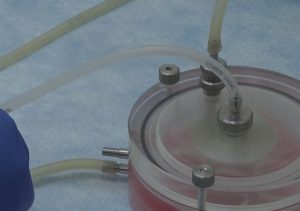Big Tobacco Study Claims E-Cigarette Vapor Is as Harmless to Human Airway Tissue as Plain Air
A new study funded by tobacco giant British American Tobacco (BAT) and published in the Toxicology in Vitro scientific journal found that electronic cigarette vapor is about as safe as air to human airway tissue.
 Scientists at British American Tobacco teamed up with the MatTek Corporation, which makes models of human cells used in ‘in vitro’ laboratory experiments, to test the potential adverse effects of e-cigarette vapor on airway tissue compared to cigarette smoke. After exposing human tracheal/bronchial epithelial cells to vapor from two commercially available e-cigarettes, they found that the damage to the airway tissue was “similar to that of air”, whereas after being exposed to cigarette smoke for six hours, the cells died.
Scientists at British American Tobacco teamed up with the MatTek Corporation, which makes models of human cells used in ‘in vitro’ laboratory experiments, to test the potential adverse effects of e-cigarette vapor on airway tissue compared to cigarette smoke. After exposing human tracheal/bronchial epithelial cells to vapor from two commercially available e-cigarettes, they found that the damage to the airway tissue was “similar to that of air”, whereas after being exposed to cigarette smoke for six hours, the cells died.
To conduct their study, researchers combined a commercially available 3D model of respiratory epithelial tissue – EpiAirway – and the popular VITROCELL smoking robot, an aerosol exposure system that mimics the exposure when humans inhale by delivering emissions from cigarettes or e-cigarettes or just air. They first tested the biological system by exposing it to known irritants in liquid form. Then, they proceeded to expose the EpiAirway tissue to cigarette smoke or e-cigarette vapor from two different types of electronic cigarettes, for up to six hours. Cell viability was measured every hour using an established colormetric test. According to the BAT press release, “the amount of particulate mass deposited on the cells’ surface was also quantified (using dosimetry tools) to prove that smoke or vapour had reached the tissue throughout exposure. The longer the time the cells were exposed, the bigger the dose they received in an incremental manner.”

Results showed that six hours of exposure to cigarette smoke reduced cell viability by 12% (near complete cell death), while neither of the two e-cigarette aerosols decreased cell viability, despite continuous and aggressive exposure. The results, in the case of respiratory epithelial tissue exposed to e-cig vapor, were similar to those of control cells exposed to only air.
“By employing a combination of a smoking robot and a lab-based test using respiratory tissue, it was possible to demonstrate the ability to induce and measure aerosol irritancy and to show that the different e-cigarette aerosols used in this study have no cytotoxic effect on human airway tissue,” said BAT spokesperson Dr Marina Murphy.
The two e-cigarettes used in this study were NJOY Bold and NJOY Menthol, so these positive results only apply to them. As the researchers themselves conclude, “further studies will be needed to compare the effects of other different commercially available products, formats and formulations.”
The good news is this study sets out a procedure that can be used to test the cytotoxicity of other electronic cigarette models and brands, and their potential for respiratory irritation or inflammation. “Currently there are no standards concerning the in vitro testing of e-cigarette aerosols,” said Marina Trani, Head of R&D at Nicoventures, a BAT subsidiary. “Our protocol could prove very useful in helping the process by which these guidelines might progress.”

Earlier this year, a German study on the toxic effects of e-cigarette vapor and cigarette smoke on human lung cells found vaping to several times less harmful than smoking, and in 2013, a team of scientists exposed fibroblast cells to both e-cigarette vapor and cigarette smoke, and found the former causes significantly less cell damage. However, the study conducted by British American Tobacco is the first to compare the effects of electronic cigarette vapor on human respiratory tissue to that of plain air.
If you’re wondering about BAT’s interest in this kind of research, you should know they are already a power player on the e-cigarette market, with their proprietary brand, Vype.
Photos: British American Tobacco















